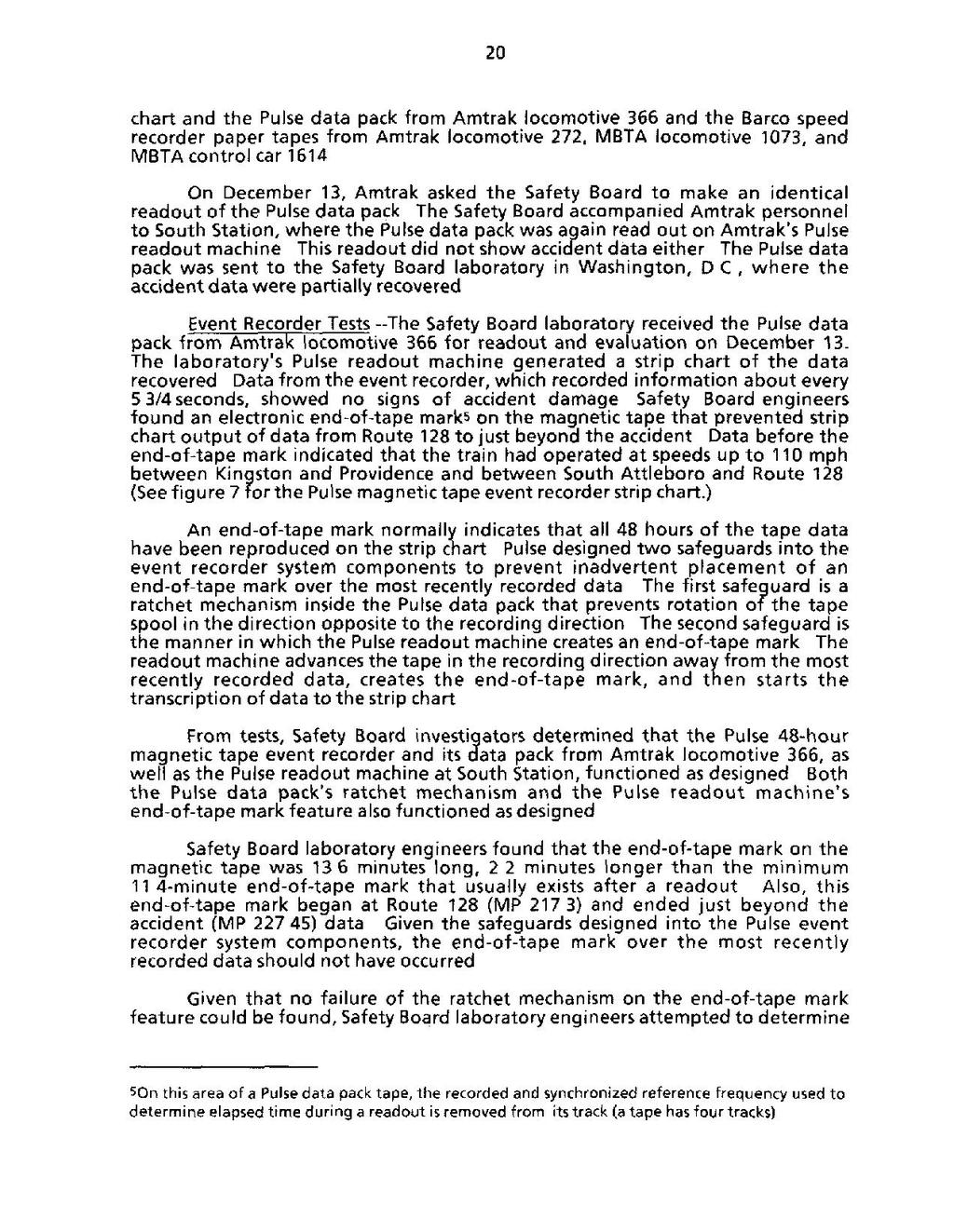20
chart and the Pulse data pack from Amtrak locomotive 366 and the Barco speed recorder paper tapes from Amtrak locomotive 272, MBTA locomotive 1073, and MBTA control car 1614.
On December 13, Amtrak asked the Safety Board to make an identical readout of the Pulse data pack. The Safety Board accompanied Amtrak personnel to South Station, where the Pulse data pack was again read out on Amtrak's Pulse readout machine. This readout did not show accident data either. The Pulse data pack was sent to the Safety Board laboratory in Washington, D.C., where the accident data were partially recovered.
Event Recorder Tests—The Safety Board laboratory received the Pulse data pack from Amtrak locomotive 366 for readout and evaluation on December 13. The laboratory's Pulse readout machine generated a strip chart of the data recovered. Data from the event recorder, which recorded information about every 5 3/4 seconds, showed no signs of accident damage. Safety Board engineers found an electronic end-of-tape mark[1] on the magnetic tape that prevented strip chart output of data from Route 128 to just beyond the accident. Data before the end-of-tape mark indicated that the train had operated at speeds up to 110 mph between Kingston and Providence and between South Attleboro and Route 128 (See figure 7 for the Pulse magnetic tape event recorder strip chart.)
An end-of-tape mark normally indicates that all 48 hours of the tape data have been reproduced on the strip chart. Pulse designed two safeguards into the event recorder system components to prevent inadvertent placement of an end-of-tape mark over the most recently recorded data. The first safeguard is a ratchet mechanism inside the Pulse data pack that prevents rotation of the tape spool in the direction opposite to the recording direction. The second safeguard is the manner in which the Pulse readout machine creates an end-of-tape mark. The readout machine advances the tape in the recording direction away from the most recently recorded data, creates the end-of-tape mark, and then starts the transcription of data to the strip chart.
From tests, Safety Board investigators determined that the Pulse 48-hour magnetic tape event recorder and its data pack from Amtrak locomotive 366, as well as the Pulse readout machine at South Station, functioned as designed. Both the Pulse data pack's ratchet mechanism and the Pulse readout machine's end-of-tape mark feature also functioned as designed.
Safety Board laboratory engineers found that the end-of-tape mark on the magnetic tape was 13.6 minutes long, 2.2 minutes longer than the minimum 11.4-minute end-of-tape mark that usually exists after a readout. Also, this end-of-tape mark began at Route 128 (MP 217.3) and ended just beyond the accident (MP 227.45) data. Given the safeguards designed into the Pulse event recorder system components, the end-of-tape mark over the most recently recorded data should not have occurred.
Given that no failure of the ratchet mechanism on the end-of-tape mark feature could be found, Safety Board laboratory engineers attempted to determine
- ↑ On this area of a Pulse data pack tape, the recorded and synchronized reference frequency used to determine elapsed time during a readout is removed from its track (a tape has four tracks).
